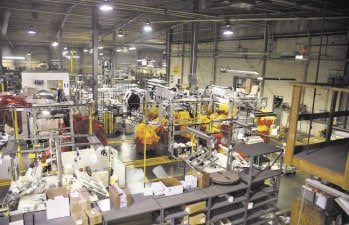2013 Year in Preview: Manufacturing & Logistics


Revenue and investment in the manufacturing sector are expected to grow moderately in 2013, according to the latest semiannual manufacturing business survey by the Institute for Supply Management.
Both large and smaller manufacturers in Greater Des Moines appear poised for growth in both sales and investment.
Deere & Co. this spring will complete a new 300,000-square-foot assembly building in Ankeny, and Bridgestone will complete a second phase of equipment upgrades to its agricultural tire plant in Des Moines. Grimes-based Ryko Solutions Inc., a global car wash equipment manufacturer and supplier, anticipates 11 percent growth in 2013, after expanding revenues by 27 percent in 2012.
U.S. manufacturing revenue is expected to increase 4.6 percent in 2013 from the year before, the ISM’s semi-annual forecast said. Actual revenue increased 4 percent in 2012 over 2011 revenue. The survey also showed that capital investment, a major driver of investment in the U.S. economy, is seen rising 7.6 percent among manufacturing firms.
“Our forecast for 2013 calls for a resumption of growth,” said Bradley Holcomb, chair of the manufacturing business survey committee at the Institute for Supply Management, in a December release. “(Respondents) are optimistic about their overall business prospects for the first half of 2013, and are even more optimistic about the second half of 2013.”
Export activity will fuel Ryko’s growth, said the company’s CEO, Steven L’Heureux. Ryko, which completed more than $1 million in plant upgrades earlier this year, plans to invest another $4 million – about 4 percent of its annual revenue – in equipment in 2013, he said. Though Europe will continue to struggle for the next couple of years due to sovereign debt problems, Ryko expects significant increases in sales to both Central and South America.
Ryko is also looking to the Southern Hemisphere for potentially adding a second manufacturing facility in 2014.
“The likelihood of that (new plant) being in the United States is probably 50-50,” he said. “I’m hearing (from other manufacturers) that there is more interest in building in Mexico, and if we were to build a plant outside the U.S., it would likely be in Central or South America.

The National Association of Manufacturers (NAM) forecasts a grim outlook for the U.S. economy if Congress fails to adequately address the fiscal cliff.
According to its study, “Fiscal Shock: America’s Economic Crisis,” the combined “double whammy” of across-the-board cuts in spending and federal tax increases would result in the loss of nearly 6 million jobs by 2014. The report, which estimated that the fiscal cliff has already shaved nearly 1 percentage point from gross domestic product growth in 2012, anticipates an additional cumulative loss of 12.8 percent in GDP growth through 2015 if the nation falls off the fiscal cliff.
Nearly 85 percent of manufacturers that responded to a separate NAM survey cited uncertainty surrounding a fiscal cliff solution as their top business challenge.
“Even if there’s a last-ditch agreement, I think it’s still going to have a chilling effect on capital spending in 2013,” said Steven L’Heureux, CEO of Ryko Solutions Inc. and a NAM member.

Manufacturers will increasingly focus on a community’s long-term viability when making site location decisions, said Rand Fisher, executive director of the Iowa Area Development Group and a board member of the Iowa Association of Business and Industry.
“Increasingly from a manufacturing standpoint, we see a number of factors coming together,” Fisher said, among them quality and affordability of labor, lower shipping costs and less risk of supply chain disruption, particularly compared with overseas locations. “We see all that fitting together to making a good site location decision.”
Particularly for small and medium-sized companies, financial incentives from state or local governments may not be a primary consideration, he said. “There’s much more of a focus on total costs than perhaps front-end incentives.”
Another trend that’s likely to continue: the largest companies are frequently working with third parties to construct their warehouse facilities, which they then lease back to free up their balance sheets. “They also even want to outsource the work force and have the building and labor lease separate so they have the flexibility to shift one or the other,” he said.











